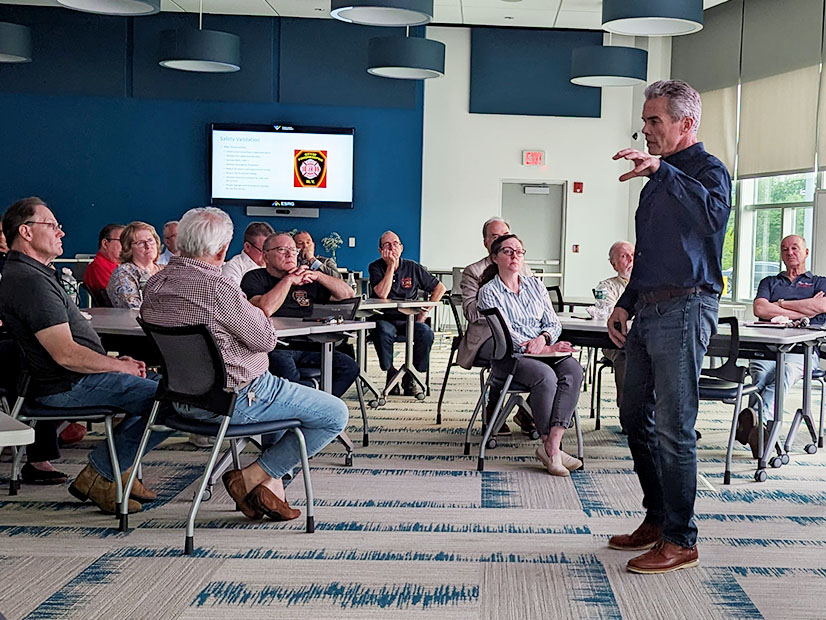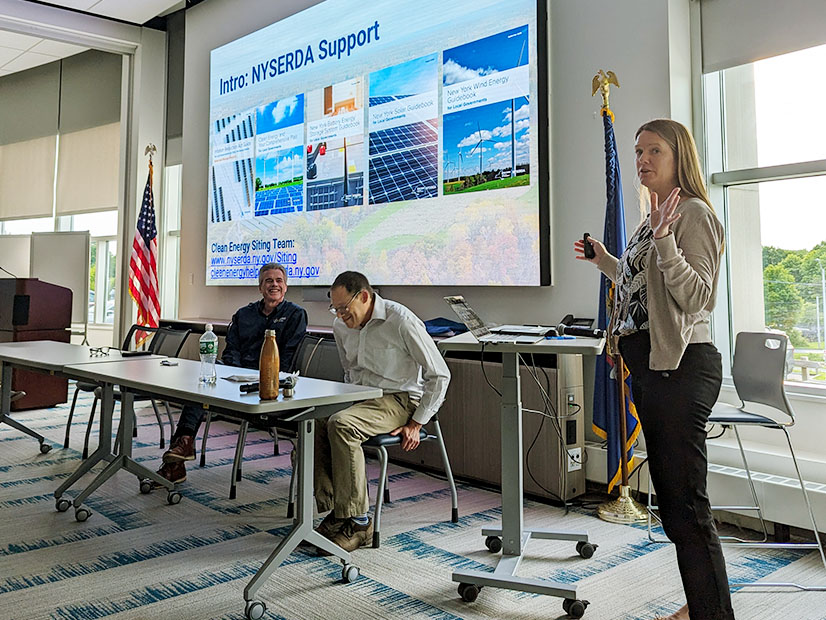PHILADELPHIA — Virginia Gov. Glenn Youngkin requested that PJM reopen the nomination process for two open seats on its Board of Managers to consider two candidates recommended by the states.
Speaking at a technical conference on the state of PJM, Youngkin said there needs to be real reform immediately at PJM, with states being given a greater voice in decision-making atop the list. Much of the full-day conference focused on the prospect of governance reforms and how the RTO can meet the challenge of rising data center load.
The request comes after Youngkin and Pennsylvania Gov. Josh Shapiro co-signed a letter to the Board of Managers urging the RTO to consider nominating former FERC Commissioners Mark Christie (R) and Allison Clements (D) to serve as board members and for a larger discussion to be launched on setting aside two seats for candidates nominated by member states.
The PJM Nominating Committee instead opted to nominate Robert Ethier, a former ISO-NE executive, and Le Xie, faculty co-director of the Power and AI Initiative at the Harvard School of Engineering and Applied Sciences. The Members Committee is set to vote on appointing Xie and Ethier during its Sept. 25 meeting, which is the voting deadline FERC granted in response to PJM’s request for a delay. (See Robert Ethier, Le Xie Nominated for PJM Board.)
In response, seven state governors signed onto a letter expressing disappointment that Christie and Clements were not nominated, saying that would have signaled that PJM is listening to the states. They wrote that the lack of board representation for consumers and state regulators is a core concern for the governors.
“Our recommendation was intended to provide a constructive solution that would have both strengthened PJM’s governance and signaled that voices representing the public interest are afforded a meaningful place in decision-making at PJM,” the governors wrote. “The Nominating Committee’s decision to disregard our recommendation indicates that our concerns for our consumers are not being taken seriously and underscores how the states’ role in PJM is being minimized.”
“PJM cannot expect to continue making decisions that affect the daily lives of our citizens and the economic future of each of the states while hiding behind stale process and refusing to grant the opportunities for meaningful input that exist in other RTOs,” they continued. “This is a fundamental and existential challenge: PJM must find ways to provide sufficient representation for the millions of consumers we represent.”
The governors added that they do not mean to discredit the qualifications of Ethier and Xie but believe they do not have the backgrounds needed to address the crisis state leaders see. They advised the board “to embrace a new, more meaningfully collaborative, vision for PJM’s relationship with the states as a whole and to take steps to ensure greater ratepayer representation as the RTO makes major decisions in the coming months.”
“Please recognize the urgency of this moment — the need is not simply for indisputably talented individuals like Dr. Ethier and Dr. Xie, but for leaders who understand the uniqueness of PJM’s member states, our citizens and our shared responsibility for the reliability and affordability of electricity,” they said. “There is a pressing need to restore trust in PJM’s governance and legitimacy.”
‘Move More Quickly’
Speaking at the conference, Youngkin said PJM has failed to forecast rising load in its footprint in time to get ahead of it, introducing interconnection bottlenecks and causing a resource adequacy crisis.
“And that is why we are working on legislation that will allow Virginia to reassess whether our utilities will continue to be part of PJM. Virginia will need to decide what is best for Virginia ratepayers. This doesn’t mean that we are walking away, but it does mean that collectively we recognize we need to represent and protect our ratepayers. And that means sending a clear, unifying signal that PJM must modernize, must reform. PJM must improve its planning and, above all, PJM must work to restore confidence that recently has been so badly lost.”
Opening the technical conference, Shapiro said PJM is at an inflection point where the states have empowered it with increasing authority to not only coordinate power flows but also ensure resource adequacy. Now it has responded too slowly to reform its interconnection process to facilitate the generation growth needed to meet rising demand.
He said the situation has been made more difficult by the Trump administration creating barriers and cutting funding for new generation. PJM was founded in Philadelphia nearly a century ago, and there’s an opportunity now to reform its governance to provide more opportunity to work with its member states.
In a press conference following his address, Shapiro said PJM should revise its leadership structure to provide more authority over decision-making to the states. And while he prefers to take a cooperative approach, he’s prepared to seek legislation requiring utilities to leave PJM absent changes.
He said PJM will need to become more sensitive to the needs of the states and consumers, including giving a voice to those entrusted to lead the states, as well as cultivating a more direct connection between state utility commissions and PJM leadership than currently exists. For those changes to be effective, he said PJM has months, not years.
“We need PJM to move more quickly … if PJM cannot do that, Pennsylvania will look to go it alone,” he said.
Maryland Gov. Wes Moore said the unified voice of 13 governors underscores the crisis at PJM, with families facing double-digit rate increases driven by the mismanagement of the regional grid. Grid oversight lacks transparency and responsiveness, which creates a need for states to have more of a hand in governance, he said.
Following the conference, 11 states signed onto a joint statement of intent outlining plans to create a PJM Governors’ Collaborative to “promote greater state and consumer representation in the governance and decision-making processes of PJM.”
The group would not hold regulatory or enforcement power, but would coordinate communications among PJM, state regulators and elected officials, FERC, the Organization of PJM States Inc (OPSI) and Consumer Advocates of the PJM States (CAPS). It also could provide technical support on topics before PJM, identify issues for the states to address, and “develop and advance joint positions and strategies related to PJM issues.” Only West Virginia and Kentucky did not sign onto the statement.


